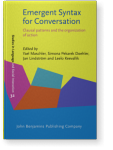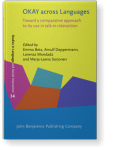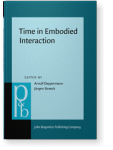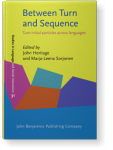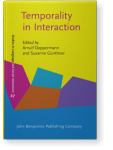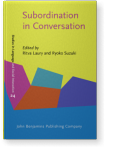Leelo Keevallik
List of John Benjamins publications for which Leelo Keevallik plays a role.
Journal
Title
Emergent Syntax for Conversation: Clausal patterns and the organization of action
Edited by Yael Maschler, Simona Pekarek Doehler, Jan K. Lindström and Leelo Keevallik
[Studies in Language and Social Interaction, 32] 2020. vi, 343 pp.
Subjects Discourse studies | Historical linguistics | Pragmatics | Syntax | Theoretical linguistics
2024 Seeing is believing: The multisensorial emergence of the Estonian näed ‘you see’ as an evidential Interactional Linguistics 4:1, pp. 38–67 | Article
Verbs of perception are known for their prolific use in various non-literal functions that are usually argued to have developed from their denotational semantics (San Roque, Kendrick, Norcliffe & Majid 2018). In this study we document interactional practices involving the Estonian 2nd person… read more
2021 Chapter 11. OKAY projecting embodied compliance to directives OKAY across Languages: Toward a comparative approach to its use in talk-in-interaction, Betz, Emma, Arnulf Deppermann, Lorenza Mondada and Marja-Leena Sorjonen (eds.), pp. 337–362 | Chapter
This chapter on Estonian and Polish OKAY focuses on complying responses to high entitlement directives. The responses are built of two parts, the verbal OKAY that completes the adjacency pair and an embodied compliance that ensues. The OKAY provides an immediate verbal notification and acceptance… read more
2021 Parental lip-smacks during infant mealtimes: Multimodal features and social functions Interactional Linguistics 1:2, pp. 241–272 | Article
The lip-smack is a communicative sound object that has received very little research attention, with most work examining their occurrence in nonhuman primate interaction. The current paper aims to dissect the social potential of lip-smacks in human interaction. The analysis examines a corpus of… read more
2020 Embodied interaction Handbook of Pragmatics: 23rd Annual Installment, Östman, Jan-Ola and Jef Verschueren (eds.), pp. 111–138 | Chapter
2020 Chapter 6. Linguistic structures emerging in the synchronization of a Pilates class Mobilizing Others: Grammar and lexis within larger activities, Taleghani-Nikazm, Carmen, Emma Betz and Peter Golato (eds.), pp. 147–174 | Chapter
This chapter targets grammar in the interactive process between a Pilates teacher and the exercising students, an activity context in which instruction and compliance can be designed to merge in time. It shows how linguistic structure, such as counts, formula, and phrases, emerges step-by-step… read more
2020 Chapter 8. Grammatical coordination of embodied action: The Estonian ja ‘and’ as a temporal organizer of Pilates moves Emergent Syntax for Conversation: Clausal patterns and the organization of action, Maschler, Yael, Simona Pekarek Doehler, Jan K. Lindström and Leelo Keevallik (eds.), pp. 221–244 | Chapter
This paper looks at the Estonian coordinating conjunction ja ‘and’ in video-recorded Pilates classes, focusing on the instructors’ practical problem of making the students perform proper movement sequences. It shows how grammatical coordination emerges within a multimodal activity in which the… read more
2020 Chapter 7. Multimodal noun phrases The ‘Noun Phrase’ across Languages: An emergent unit in interaction, Ono, Tsuyoshi and Sandra A. Thompson (eds.), pp. 153–178 | Chapter
In co-present interaction, our bodies are continuously available for sense-making. Linguists, however, have generally analyzed grammatical patterns, such as noun phrases, separately from the rest of human behavior. This chapter looks at a collection of cases in Swedish, English, and Estonian,… read more
2020 Chapter 2. ‘I understand’-initiated formulations of the other: A semi-fixed claim to the intersubjective Fixed Expressions: Building language structure and social action, Laury, Ritva and Tsuyoshi Ono (eds.), pp. 11–40 | Chapter
Some language patterns appear fixed at a certain time, enabling their description as grammatical structures. Semi-fixed patterns that routinely accomplish specific social actions constitute more of an analytical challenge. This chapter targets the phrase ma saan aru ‘I understand’ in Estonian… read more
2020 Chapter 1. Complex syntax-in-interaction: Emergent and emerging clause-combining patterns for organizing social actions Emergent Syntax for Conversation: Clausal patterns and the organization of action, Maschler, Yael, Simona Pekarek Doehler, Jan K. Lindström and Leelo Keevallik (eds.), pp. 1–22 | Chapter
2018 Chapter 3. The temporal organization of conversation while mucking out a sheep stable Time in Embodied Interaction: Synchronicity and sequentiality of multimodal resources, Deppermann, Arnulf and Jürgen Streeck (eds.), pp. 97–122 | Chapter
Based on talk-oriented activities, there seems to be a consensus that turn-taking is organized to minimize gaps between turns. This study looks at a conversational sequence that evolved in a multi-party setting during a joint cleaning of a sheep stable, and analyzes how nextness is accomplished in… read more
2018 Chapter 11. Making up one’s mind in second position: Estonian no-preface in action plans Between Turn and Sequence: Turn-initial particles across languages, Heritage, John and Marja-Leena Sorjonen (eds.), pp. 315–338 | Chapter
This chapter discusses preferred responses that are delayed in their turn by the initial particle no in Estonian. It demonstrates that the turn-initial time-space may be employed for a display of “making up one’s mind”, either weighing matters outside the conversation or something already discussed… read more
2017 Chapter 9. Negotiating deontic rights in second position: Young adult daughters’ imperatively formatted responses to mothers’ offers in Estonian Imperative Turns at Talk: The design of directives in action, Sorjonen, Marja-Leena, Liisa Raevaara and Elizabeth Couper-Kuhlen (eds.), pp. 271–295 | Chapter
This study looks at offer sequences in Estonian with an analytical focus on answers in the imperative form. “Telling someone to do something” has traditionally been considered an initiating action, typically an order. In this study, however, Estonian speakers are shown to produce “orders” in… read more
2015 Coordinating the temporalities of talk and dance Temporality in Interaction, Deppermann, Arnulf and Susanne Günthner (eds.), pp. 309–336 | Article
2014 Having a ball: Immaterial objects in dance instruction Interacting with Objects: Language, materiality, and social activity, Nevile, Maurice, Pentti Haddington, Trine Heinemann and Mirka Rauniomaa (eds.), pp. 249–268 | Article
This chapter looks at how immaterial objects are manipulated into being for pedagogical purposes. Dance teachers employ objects to visualise subtle tactile and kinaesthetic experiences. The objects emerge in a situated manner within activity metaphors where alternative bodily activities are… read more
2012 Compromising progressivity: ‘No’-prefacing in estonian Pragmatics 22:1, pp. 119–146 | Article
Negative polar particles have generally been characterized as items for expressing disagreement or responding negatively to polar questions. What has been lacking in these accounts is attention to embodied activities. This paper studies the usage of the Estonian negative particle ei as a preface… read more
2011 Interrogative “complements” and question design in Estonian Subordination in Conversation: A cross-linguistic perspective, Laury, Ritva and Ryoko Suzuki (eds.), pp. 37–68 | Article
Some interrogative subject and object complement clauses are not treated as subordinate in Estonian interaction. They are interactionally profiled, as participants answer them as questions. Grammatically, they behave like independent clauses, displaying inversion and the turn-final question… read more
2010 Pro-adverbs of manner as markers of activity transition Studies in Language 34:2, pp. 350–381 | Article
This paper explores the phenomenon that pro-adverbs of manner are cross-linguistically used to mark transitions from one activity to another. In Estonian, the pro-adverb nii is used for this purpose. Among Estonian refugees in Sweden, an activity transition is frequently marked with soo. Both nii… read more
2010 The interactional profile of a placeholder: The Estonian demonstrative see Fillers, Pauses and Placeholders, Amiridze, Nino, Boyd Davis and Margaret Maclagan (eds.), pp. 139–172 | Article
Fillers are used to delay the next due unit in talk. The study argues that there may be interpersonal advantages in the delay of key items in turns, such as easing the processing for the recipient, announcing structural boundaries in conversation, and displaying orientation to the sensitiveness of… read more
2008 Conjunction and sequenced actions: The Estonian complementizer and evidential particle et Crosslinguistic Studies of Clause Combining: The multifunctionality of conjunctions, Laury, Ritva (ed.), pp. 125–152 | Article
The usage patterns of the Estonian complementizer et in sequentially embedded actions show that it functions as an evidential particle. In oral as well as Internet interaction, clause-initial et attributes upcoming content to the previous speaker/writer and thereby incorporates another voice.… read more

